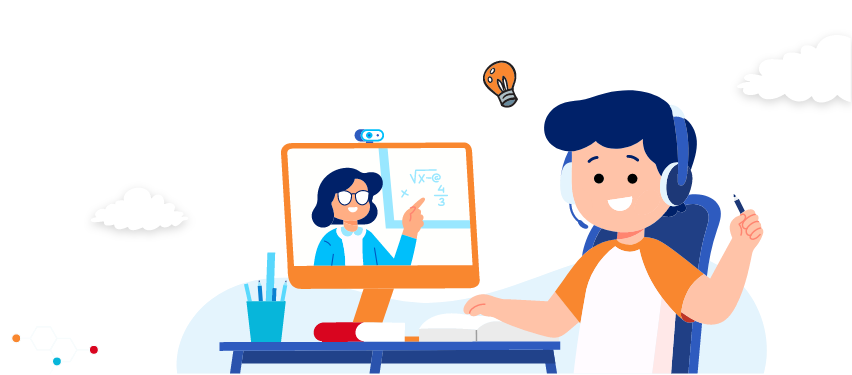In today’s tech-driven world, understanding the connection between coding and math has become increasingly important for young learners. While coding may seem like it’s all about computer languages and logic, its foundation is deeply rooted in mathematics. The synergy between coding and mathematics enhances students’ computational thinking and problem-solving skills, making them more adept in both subjects. In this blog, we’ll explore how coding improves math skills and why learning to code is a powerful way to strengthen mathematical abilities. Explore our courses like Robotics & Coding to get started!
1. Coding and Math Connection
At the core, coding is the practical application of various mathematical concepts. Writing code involves the use of logic, algorithms, and functions that are all heavily based on math. Let’s dive into the different ways programming and mathematics are intertwined:
- Algebra: Coding uses variables, functions, and equations similar to algebra. When kids learn to code, they manipulate data and variables, developing a deeper understanding of algebraic concepts.
- Geometry: Whether it’s developing games or animations, geometry plays a vital role. Coding helps students apply their knowledge of shapes, angles, and coordinates to create movement and visuals, enhancing their spatial reasoning.
- Statistics: Coding in data science or machine learning requires a strong understanding of statistics. Students learn to collect, analyze, and interpret data, directly applying statistical principles in real-world scenarios.
2. How Coding Helps Math
One of the major benefits of coding is how it strengthens mathematical skills. Coding teaches students to think logically, a skill directly tied to mathematics. Here are a few ways in which coding improves math skills:
- Decomposition: Coding breaks down complex problems into smaller tasks, much like how math breaks large problems into simpler steps. This teaches students how to approach problems methodically.
- Pattern Recognition: Programming encourages students to recognize patterns, a fundamental concept in mathematics, which helps solve recurring problems more efficiently.
- Abstract Thinking: Just like in math, coding requires students to focus on essential elements while ignoring unnecessary details. This strengthens their ability to think abstractly and solve problems creatively.
3. Programming and Mathematics in Practice
Coding doesn’t just use math – it actively reinforces it. For instance, in coding:
- Loops and Iterations: Coding loops help kids understand repetitive mathematical operations, making concepts like multiplication and addition more intuitive.
- Conditional Statements: Logical statements in coding, such as “if-else,” mirror mathematical logic, teaching students how to work with probabilities and logical operators.
Through coding, students gain hands-on experience with math, applying abstract theories in practical, real-world projects.
4. Why Coding is Essential for Math Learning
For many students, math can feel disconnected from real-life applications. Coding bridges this gap by making math interactive and engaging. When students code, they see how mathematical concepts like coordinates, functions, and logic are applied to build software, games, and websites. This practical application helps students develop a stronger interest in both coding and math.
For younger learners, block-based coding platforms allow them to visualize how math concepts like angles, measurements, and geometry affect a program’s output. As they advance to languages like Python or JavaScript, they encounter more complex programming and mathematics challenges, such as building algorithms or data models.
5. Careers Where Coding and Math Collide
A solid understanding of both coding and math opens up numerous opportunities in fields like engineering, data science, robotics, and artificial intelligence. For example:
- Data Scientists use coding to analyze large datasets and apply statistical models, blending programming and math seamlessly.
- Robotics Engineers need coding skills alongside geometry and trigonometry to control robotic movements and solve real-world challenges.
- Software Engineers rely on mathematical logic, algebra, and algorithms to optimize code and improve system performance.
6. Courses to Get Started at Little Inventors
If you’re looking to introduce your child to coding while strengthening their math skills, Little Inventors offers a variety of engaging courses that bridge the gap between coding and math.
Some courses include:
- Python Programming: A beginner-friendly course that teaches the fundamentals of coding, focusing on logical thinking and algorithmic problem-solving, which are rooted in mathematical concepts.
- Machine Learning: In this course, students learn how to use data, build models, and understand algorithms, applying math concepts such as algebra, statistics, and probability.
- Robotics and Coding: Combining programming and mathematics, this course teaches students how to control robots through coding, applying their knowledge of geometry, logic, and problem-solving.
These courses are designed to make coding fun and interactive, while simultaneously strengthening students’ math skills.
Conclusion: The Power of Coding and Math Together
The connection between coding and math is undeniable. By learning to code, students not only enhance their computational skills but also improve their mathematical abilities. Coding teaches critical thinking, problem-solving, and logical reasoning, all of which are essential for mastering math. With programs like Little Inventors, students can explore the world of coding while strengthening their foundation in mathematics, preparing them for future careers in technology, engineering, and more. Invest in your child’s future today by enrolling them in a Mathematics Course for Kids that combines the power of coding and math at Little Inventors. Let them discover how coding improves math skills and opens up endless possibilities for creative problem-solving!

